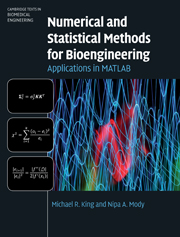Book contents
- Frontmatter
- Contents
- Preface
- 1 Types and sources of numerical error
- 2 Systems of linear equations
- 3 Probability and statistics
- 4 Hypothesis testing
- 5 Root-finding techniques for nonlinear equations
- 6 Numerical quadrature
- 7 Numerical integration of ordinary differential equations
- 8 Nonlinear model regression and optimization
- 9 Basic algorithms of bioinformatics
- Appendix A Introduction to MATLAB
- Appendix B Location of nodes for Gauss–Legendre quadrature
- Index for MATLAB commands
- Index
- References
1 - Types and sources of numerical error
Published online by Cambridge University Press: 05 June 2012
- Frontmatter
- Contents
- Preface
- 1 Types and sources of numerical error
- 2 Systems of linear equations
- 3 Probability and statistics
- 4 Hypothesis testing
- 5 Root-finding techniques for nonlinear equations
- 6 Numerical quadrature
- 7 Numerical integration of ordinary differential equations
- 8 Nonlinear model regression and optimization
- 9 Basic algorithms of bioinformatics
- Appendix A Introduction to MATLAB
- Appendix B Location of nodes for Gauss–Legendre quadrature
- Index for MATLAB commands
- Index
- References
Summary
Introduction
The job of a biomedical engineer often involves the task of formulating and solving mathematical equations that define, for example, the design criteria of biomedical equipment or a prosthetic organ or physiological/pathological processes occurring in the human body. Mathematics and engineering are inextricably linked. The types of equations that one may come across in various fields of engineering vary widely, but can be broadly categorized as: linear equations in one variable, linear equations with respect to multiple variables, nonlinear equations in one or more variables, linear and nonlinear ordinary differential equations, higher order differential equations of nth order, and integral equations. Not all mathematical equations are amenable to an analytical solution, i.e. a solution that gives an exact answer either as a number or as some function of the variables that define the problem. For example, the analytical solution for
(1) x2 + 2x + 1 = 0 is x = ±1, and
(2) dy/dx + 3x = 5, with initial conditions x = 0, y = 0, is y = 5x − 3x2/2.
Sometimes the analytical solution to a system of equations may be exceedingly difficult and time-consuming to obtain, or once obtained may be too complicated to provide insight.
- Type
- Chapter
- Information
- Numerical and Statistical Methods for BioengineeringApplications in MATLAB, pp. 1 - 46Publisher: Cambridge University PressPrint publication year: 2010



